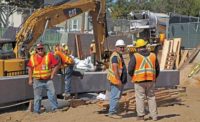The ability of emergency contractors to speedily mobilize extra workers and equipment—combined with fire damage being less severe than initially feared—made reopening of a 450-ft section of Interstate 10 in Los Angeles possible in eight days last fall. Work continues to shore up columns with steel bracing and repair damaged concrete.
After the Nov. 11 fire shut down a portion of I-10 near downtown, officials worried if demolition and replacement were needed, an approach that could take four to eight months. “This thing is going to have to come down,” Federal Highway Administration head Shailen Bhatt said upon initial visual inspection of the damage, according to a recollection by Ramon Hopkins, construction division chief for the California Dept. of Transportation (Caltrans).
Hopkins spoke at a virtual event Jan. 12 sponsored by BuildOUT California in collaboration with AGC of California and CALINFRA.
But samples taken from the highway deck, soffits and columns showed far less damage than feared, Hopkins noted.
That pared the fix time estimate down to eight weeks. The eventual determination that the amount of shoring of bents needed was half as much as initially thought further bolstered the reopening timeframe. Stress gauges and other instrumentation now show no deformation or vibrations under live traffic; the section carries about 300,000 vehicles daily.
Hopkins also credited emergency contractors Griffith Co. and Security Paving for swift mobilization. Griffith removed 154 truck loads of debris within 48 hours, he noted.
“It was 24/7 for seventy-two hours,” said Ben Walnum, senior project manager at Griffith.
Security Paving, which started with six hydraulic jacks, managed to secure an additional 30, also speeding the reopening, Hopkins added. The contractor developed a falsework plan within 10 hours and used 870,000 lb of beams, posts and steel to erect 54 falsework bents.
“It was all hands on deck,” said Brian Algren, Security Paving senior vice president, noting that personnel ramped up from 40 to 80 by the end of the first week. “We got the falsework up pretty quickly.”
Crews are installing 58 steel casings to brace the columns, with grouting or use of self-consolidating concrete to patch them up, he added. After that, workers will replace damaged concrete on the soffits. Algren estimated that two months’ worth of work remain on the column repairs. While it’s “less clear” how long the soffit repairs will take, he estimated all work will be done by June.
Local Impact
While the section reopened in eight days, an off-ramp took a a little longer. “Economic prosperity was a concern,” Hopkins said, noting the impact on businesses located nearby.
Work to reopen the section cost about $6 million, with total repair estimates ranging up to $10 million, said Hopkins. The federal government is expected to fully reimburse Caltrans, he added.
Caltrans uses an emergency contractor registry, and chose Griffith and Security Paving based on their proximity and ability to fill the required roles. The agency and contractors also used small, local and disadvantaged businesses as much as possible for such tasks as welding the bracing and addressing electrical systems, Hopkins said.
He also credited the union crews for being “tireless … agile and flexible.”




Post a comment to this article
Report Abusive Comment